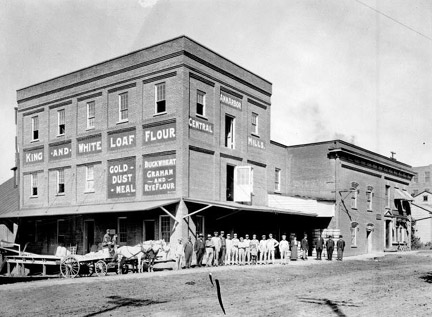
History of the Allen Creek Area

At the time Ann Arbor was officially registered in May of 1824 Allen Creek was free flowing relatively undisturbed by human activity. This began to change however as interest in the Ann Arbor territory grew. Settlement patterns began to encroach along the lands proximal to Allen Creek and its tributaries because the creek provided residents easy access to water for drinking, cleaning and for dumping wastes. Residents of Ann Arbor used Allen Creek for many other uses as well. Allen Creek was used as the City's first known bathhouse, situated at Liberty and 1st Streets, the bathhouse was described as a white, octagonal building with a sharp spire in the middle with Victorian scrolls around the eaves (Grace Shackman). During the 1860-'s Ann Arbor resident took advantage of Allen Creek 's low topography in creating a skating park near Miller and 1st by damming up Allen Creek and a couple of its tributaries.
Industries also located their facilities next to Allen Creek to take advantage of its potential as a source of power, water and waste disposal. Water intensive industries such as tanneries, breweries, and mills were common all along Allen Creek. Figure 2.1 shows Ann Arbor Central Mills as it looked in 1902, situated between First Street (shown) and Allen Creek. This same building was once a brewery as well, using Allen Creek to cool its beer. This same building is still in use but now contains a variety of nightclubs. Industrial build up around Allen Creek was not only influenced by the creek but also by the railroad that was to be built along the creek.
Because of rising concern regarding the over-reliance on the University of
Michigan's role as a source of economic prosperity the Ann Arbor Railroad was
constructed in 1878 to diversify Ann Arbor's economic base by attracting more
intensive industry. Taking advantage of Allen Creek 's level topography, the
railroad was built roughly paralleling the course of the creek. As a result
of the railroad's presence, the Allen Creek corridor grew rapidly and emerged
as a prime location for industrial production. But as industry became more mechanized
through technological advancement and as rail transport faded in importance,
Allen Creek's prominent role in Ann Arbor's economy similarly faded. Industry
in Allen Creek North was abandoned leaving sites contaminated with heavy metals
such as Arsenic and Lead, which presents a considerable obstacle to future development
in this area.
As development progressed, however, impermeable surfaces began to increase in
the Allen Creek valley and in the surrounding watershed. Rainfall that is normally
absorbed by natural landscapes tends to "runoff" from impermeable
surfaces such as rooftop, paved roads, and parking lots, and then collects into
Allen Creek and it tributaries. This greatly increased the volume and velocity
of water in the creek thus increasing the potential of flooding during heavy
rains. In response to continued complaints about flooding from residents that
resided within Allen Creek 's floodplain, the city of Ann Arbor in 1926 embarked
on a series of public service projects that would eventually enclose most of
Allen Creek and its tributaries inside concrete culverts to protect residents
from damaging floods.
Since enclosing the creek, impermeable surfaces have continued to increase as the population of Ann Arbor grew. By 1995, 45.8% of the Allen Creek watershed, which lies entirely within Ann Arbor's city limits, was covered by impermeable surfaces. According the Schuler (1995), as every acre of natural meadow is converted to impermeable surfaces, the volume of water runoff s estimated to increase approximately 16 fold. The dangerous combination of increased volume and velocity of water has increased the potential of damaging floods for individuals that reside in the Allen Creek floodplain. Because the volumes and velocities of water runoff have increased so dramatically, current capacity of the Allen Creek drain is now inadequate and overburdened. Increased complaints by residents about flooded basements and objections to the regulations that restrict certain uses on property within the Allen Creek floodplain/floodway continue to intensify the debate over how Allen Creek North will evolve.
The Washtenaw County Drain Commission recently approved a storm water management code (Chapter 63) that requires landowners within Ann Arbor to improve storm water quality on sit if any type of construction is performed. Methods of improving storm water quality include the construction of retention basins, or by reducing the overall impervious surfaces on the particular site. Although highly commendable in its goals, this ordinance has made any type of development within Allen Creek North even more difficult considering this area lies almost entirely with Allen Creek's floodplain and floodway where development is already restricted by multiple layers of governmental jurisdiction over floodplains and floodways. The Federal Emergency and Management Agency (FEMA), the Michigan Department of Environmental Quality (MDEQ), and the Washtenaw County Drain Commission all retain some level of jurisdiction over the Allen Creek floodplain and floodway.
Even though Allen Creek North suffers from significant barriers to development
there remains great potential to revitalize this once vibrant industrial corridor
of Allen Creek North. Currently, the development in Allen Creek North is stagnant
even while Ann Arbor experiences a boom in downtown construction. To keep pace
and evolve with the adjacent downtown, Allen Creek North needs to find new and
creative ways to foster development while respecting the environmental realities
that shape this areas future.